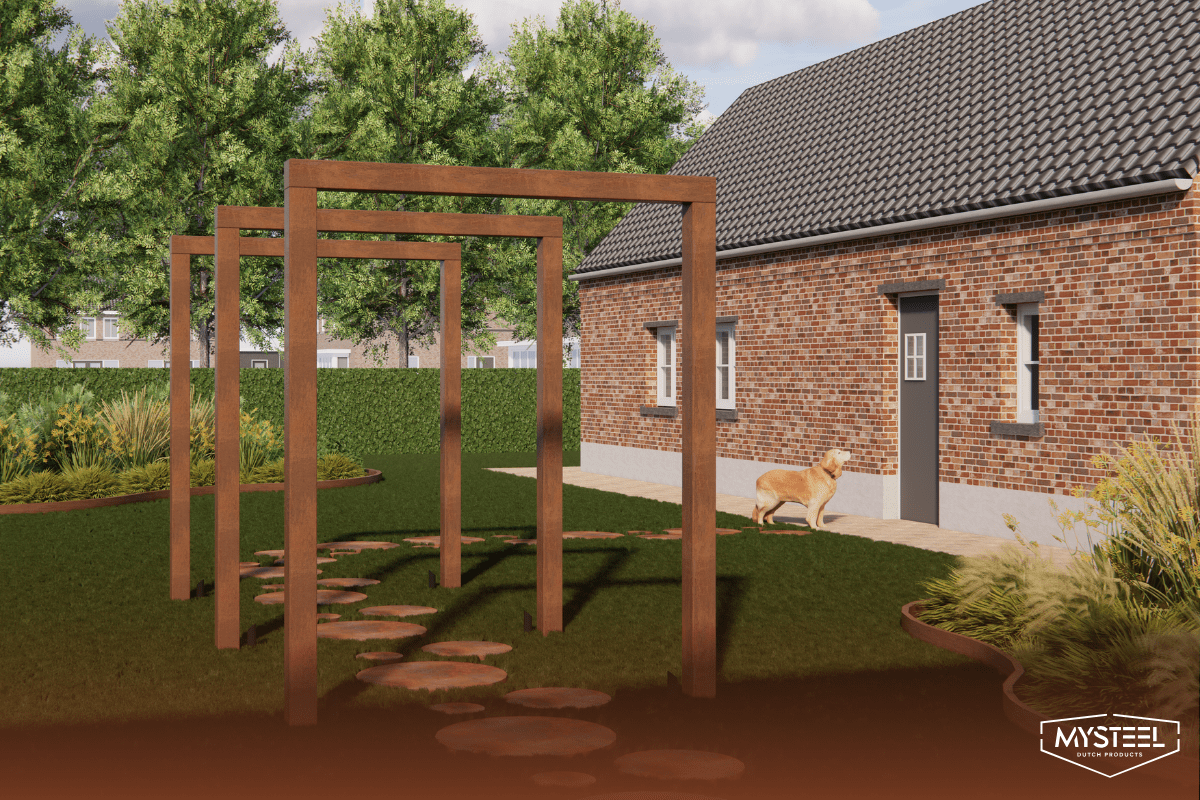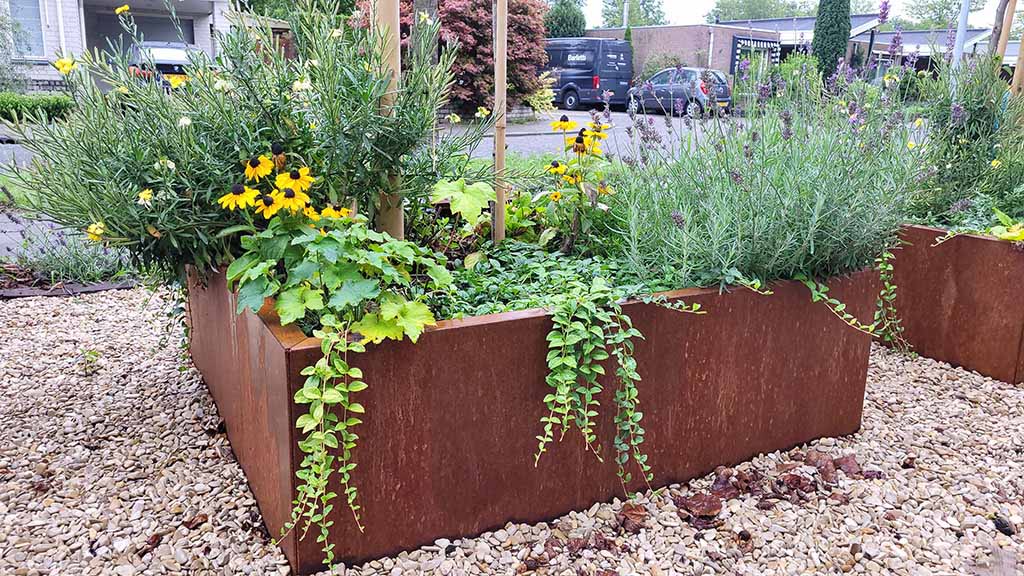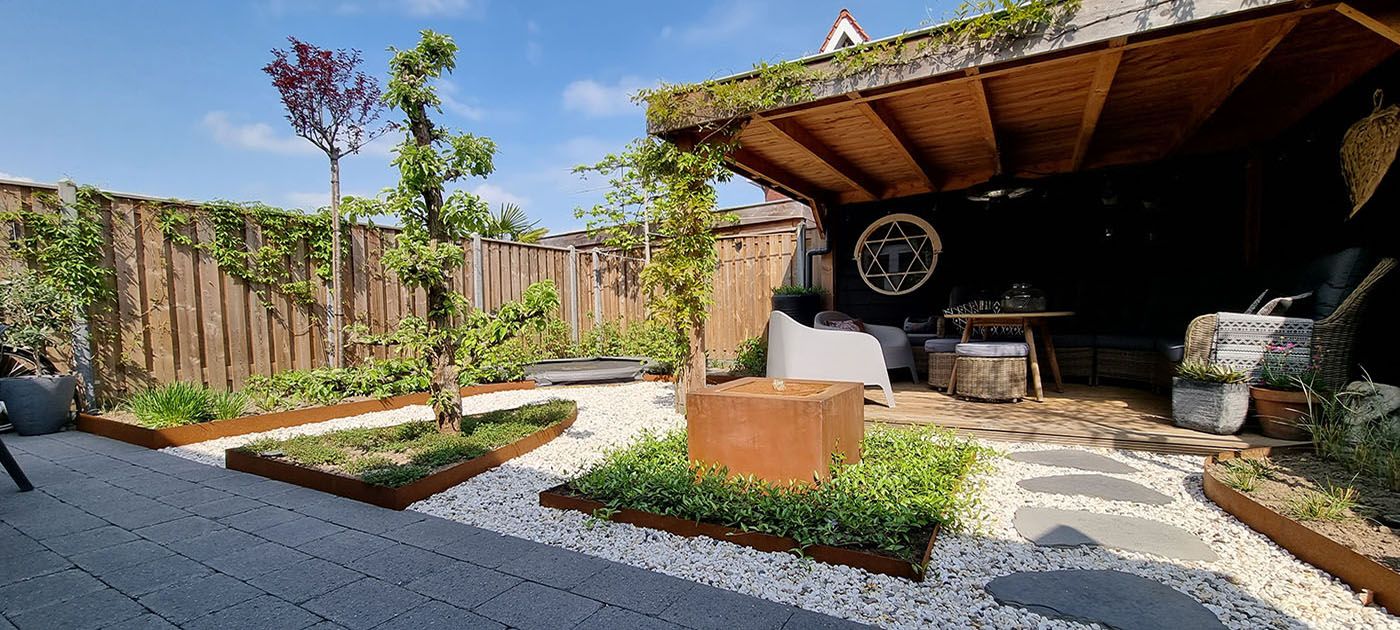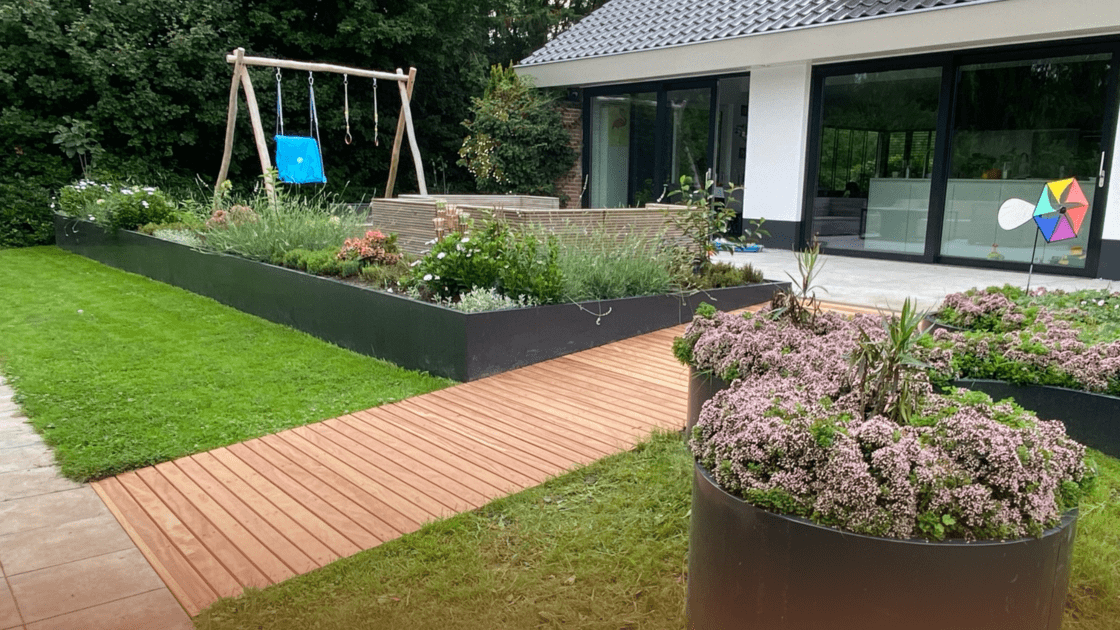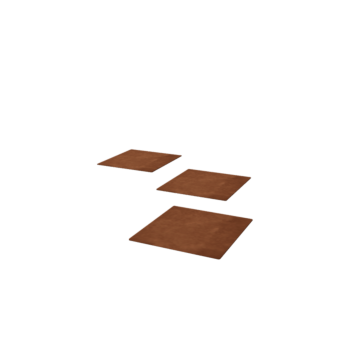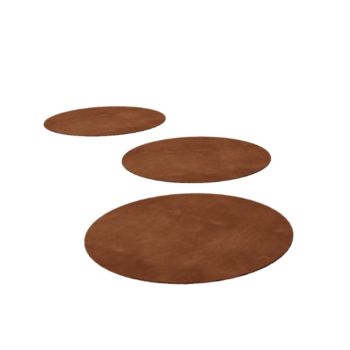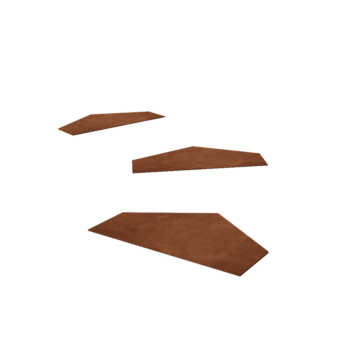How to Lay Corten Steel Paving Stones in the Garden?
Many people choose to lay stepping stones in their garden because they are very versatile and have numerous benefits. They can connect different parts of your garden and also look nice.
There are various types of stepping stones, so they fit perfectly into any garden or outdoor space. Corten steel stepping stones, for example, are popular due to their durability and unique rusty appearance. The material is sturdy and can withstand different weather conditions.
Moreover, it is not difficult to install stepping stones. In this blog, we will explain step by step how you can do this yourself. We provide a clear guide and give you tips on how to properly prepare the soil and choose the right distance between the stones.
Summary
- Stepping stones are a beautiful and practical addition to your garden.
- The distance between the stepping stones depends on various factors, such as appearance and walking comfort.
- Before placing the stepping stones, it is important to properly prepare the soil.
- The stones can be heavy. Lift them properly: use your legs to lift, work with someone else, or use a tool to protect your back.
- You can add gravel between the stepping stones for an even nicer result.
What are Stepping Stones for in the Garden?
Stepping stones can make your garden more beautiful and practical in various ways. With stepping stones, you can:
- Create paths through your garden: Stepping stones help you to create paths through your garden, allowing easy access to different areas without damaging your grass or plants.
- Accentuate certain parts of your garden: By placing stepping stones wisely, you can highlight certain areas of your garden, such as a beautiful flowerbed or a pond. This way, you can draw attention to the most beautiful parts of your garden.
- Connect different parts of your garden: With stepping stones, you can link different areas of your garden, such as the patio and a seating area. This creates a sense of cohesion.
- Add structure and design elements: Stepping stones are not only practical but also give your garden a unique appearance.
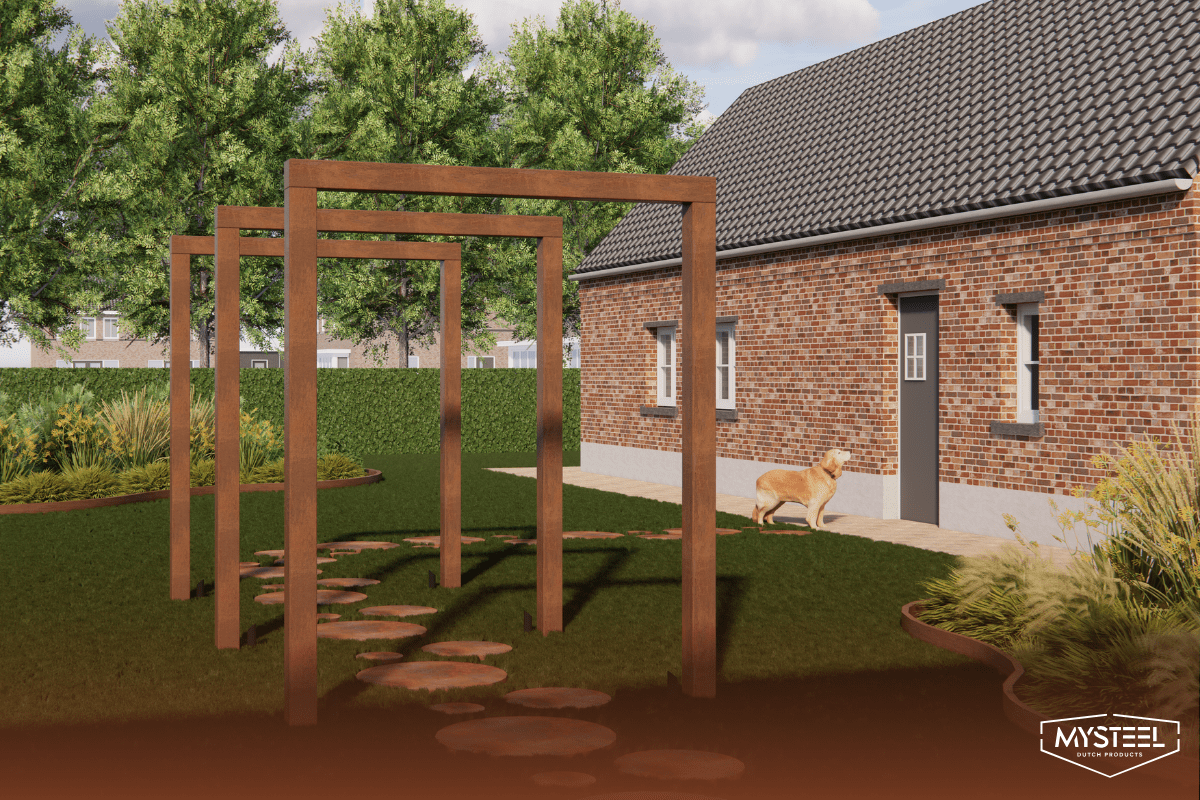

How Much Distance Should Be Between the Stepping Stones?
The distance between the stepping stones plays an important role in both the aesthetics and functionality of your garden path. How far apart the stepping stones should be depends on various factors:
Aesthetics
If you want a compact look for your garden with narrow bordering plants, you can place the stepping stones close together. Prefer thicker bordering plants or grass around the stepping stones? Then you can leave more space between the stones. The choice fully depends on your personal preference and the design of your garden.
Walking Comfort
The walking comfort also plays a significant role in your considerations. If you choose to keep the space between the stones equal, then all steps will be of the same size. This creates a uniform feeling and makes it easier to walk comfortably.
A more playful arrangement with different distances between the stones can give an interesting and dynamic appearance to your garden but can also be less predictable. People may need to walk more carefully over the stones to avoid tripping.
Users
Also consider who will mainly walk on the stepping stones when determining the distance between them:
- Children: Children usually take smaller steps, so it is handy if the stones are closer together.
- Tall Adults: Tall adults often take larger steps, so they need more space between the stones to walk comfortably.
- Shorter Adults: Shorter adults also often take smaller steps, so they need a smaller space between the stones for a comfortable walk.
Not sure how much space to leave between your stepping stones? It’s a good idea to test the planned walking distance first before placing the stepping stones permanently. Temporarily lay the stones on the ground and walk over them several times to feel whether the distance is comfortable for you. Adjust the gap as necessary to improve walking comfort and reduce the risk of tripping.
Soil Preparation
Before you lay the stepping stones, it is important to prepare the soil properly. This ensures that the stepping stones are stable and durable. Here are some things to consider:
What Sand Should You Lay Under the Stepping Stones?
Use joint sand on top of the regular soil. Joint sand has several advantages:
- Good Stability: Joint sand has the right texture and grain size to provide a solid base for the stepping stones. This prevents them from sinking or shifting after a while.
- Drainage: It also allows water to flow through easily. This helps to prevent water from standing under the stepping stones.
- Prevents Weeds: Joint sand also helps to suppress weed growth. This keeps your garden neat and tidy.
How Can You Prevent Sinking?
To prevent the stepping stones from sinking, it is important to prepare the subsoil properly. Dig deep enough and remove any loose stones, plant roots, or other debris. When the subsoil is smooth and clean, it is easier to place the stepping stones.
Then use joint sand and compact it well. This creates a solid base and ensures that the stones stay in place.
Can You Lay Stepping Stones on Grass?
If you want to lay stepping stones in grass, you should consider the following disadvantages:
- Dead Grass: The grass under your stepping stones will eventually die as it will not receive light and air.
- Unstable Subsoil: Grass is less stable than soil. This can cause your stepping stones to sink or shift more quickly.
- Poor Drainage: Grass retains moisture, which can lead to sinking and muddy spots.
- Uneven Stones: Sinking can cause the stones to become uneven. This not only looks sloppy but also increases the risk of tripping.
- Maintenance: If the stones are not in but on the grass, it is more difficult to mow the grass around the stones. The stone will be higher than the grass, and the blades of the lawn mower might hit the stones.
Would you still like to lay stepping stones on grass?
Then you can cut out the grass around the stepping stone so that the stepping stone fits nicely into the grass. You can use extra soil to raise the stepping stone, reducing the height difference with the surrounding grass.
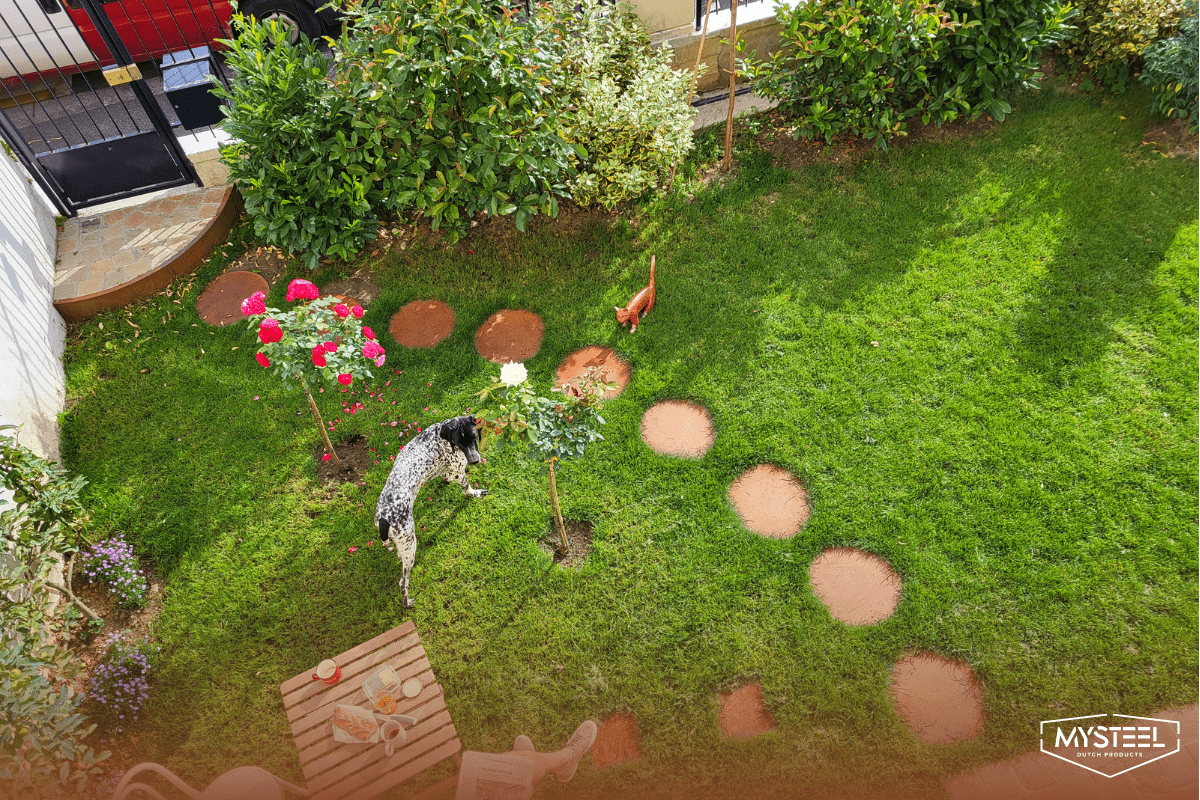

Step-by-Step Plan: Laying Stepping Stones in Grass in 11 Steps
Would you like to lay stepping stones in your lawn yourself? Below you will find a clear step-by-step plan to help you with that. Follow these instructions to ensure that your stepping stones are solid and evenly laid. This way, you can enjoy a beautiful garden path.
Step 1: Determine the Location and Lay Out the Stepping Stones
Mark the spots where you want to lay the stepping stones and lay the stones out at the desired distance. Not sure how far apart to lay the stones? In the section 'How Much Distance Should Be Between the Stepping Stones?' you'll read how to tackle that.
Step 2: Dig Out the Ground or Cut Away the Grass
Once you know where you want to place the stones, dig out the area where the stepping stones will go to make space for the sand bed. How deep you need to dig depends on the thickness of the stepping stone:
- Stepping stone less than 1 cm thick (the stepping stones from MySteel are 3 mm thick):
- Dig the ground about 2 to 3 cm deep.
- Stepping stone 2 cm thick:
- Dig the ground about 3 to 4 cm deep.
- Stepping stone 5 cm thick:
- Dig the ground about 6 to 7 cm deep.
Do you want to place the stepping stones in the grass? Then place the stone on the grass and cut around the edges of the stepping stone with a utility knife. Then remove the grass section.
Step 3: Level the Subsoil
Then level the ground where the stepping stones will go as even as possible. You can do this with a level and a straight plank. This prevents height differences, which can ultimately cause shifting or even sinking.
Step 4: Lay a Layer of Joint Sand
After leveling the ground, apply a layer of joint sand. The thickness of this layer depends on the size and thickness of the stepping stones, but a layer of 3 to 5 centimeters is usually sufficient. The joint sand ensures that the stones stay firmly in place.
Step 5: Even Out the Sand Bed and Compact It
With a straight plank or rake, you can evenly distribute the joint sand. To create a solid base, walk or press carefully over the sand bed.
Step 6: Check the Level
Then use a level again to check whether the sand bed is completely flat. If it is not completely even, you can add or remove some extra sand. This step is important to ensure that the stepping stones are laid nice and straight and stable.
Step 7: Place the Stepping Stones
Place the stepping stones on the sand bed you just made and press them firmly down. This ensures that they make good contact with the sand and lie firmly in place.
Step 8: Check the Level of the Stepping Stones
Use a level again to check whether the stepping stones are level. If they are not, you can easily remove or add some sand to ensure that the surface stays even.
Step 9: Fill the Joints with Joint Sand
Have you laid all the stepping stones correctly? Then it's time to fill the spaces between the stones with joint sand. You can use a broom to evenly distribute the sand over the joints.
Step 10: Pack the Joint Sand Firmly
To ensure that the sand settles well between the joints, you can carefully walk over the stepping stones a few times.
Step 11: Repeat if Necessary
Add extra joint sand and repeat the compaction process until the joints are well filled. This keeps the stepping stones firmly in place and prevents them from shifting.
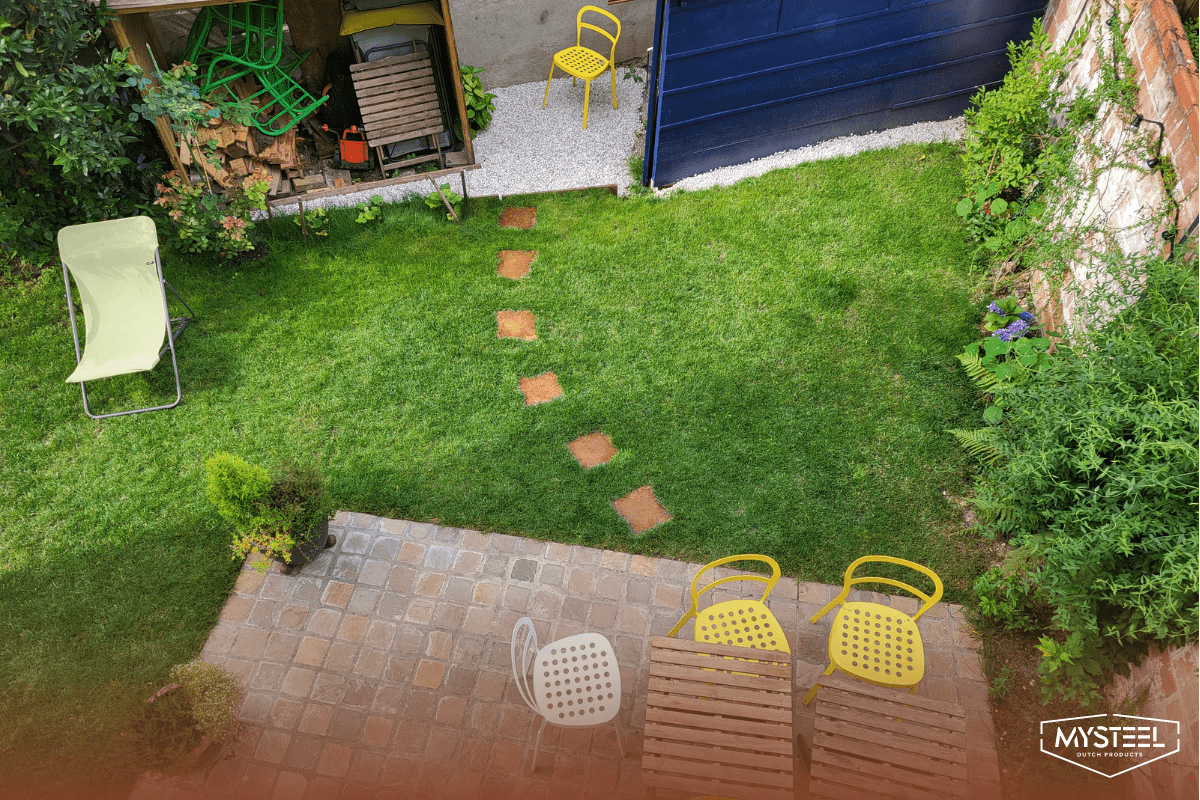

How to Avoid Back Pain When Laying Stepping Stones?
The corten steel stepping stones from MySteel vary in weight depending on their size:
- The smallest stepping stone (30x30 cm) weighs about 2 kg. Most people can lift that easily.
- The largest stepping stone (75x75 cm) weighs about 14 kg. It is best to lift these stones with two people or with a lifting device, such as a Tile Donkey. This special tool is designed to lift and move heavy stones without straining your back.
Are you still going to lift yourself? Do it the right way. It is better to lift using your legs rather than your back. This helps reduce strain on your back and prevent injuries. For larger and heavier stones, it's helpful to roll them to the right spot to lessen the strain on your back.
Gravel Between the Corten Steel Stepping Stones
By laying stepping stones in gravel, you can enhance the beauty of your garden. Here are some important things to think about and tips to ensure that your gravel path with stepping stones looks gorgeous:
Different Types of Gravel
By combining gravel with corten steel stepping stones, you can create a garden path that not only looks good but is also functional. There are various types of gravel to choose from. They all have unique properties. It is important to choose something that you like and that matches your garden well.
Here are some examples:
- River Gravel: This gravel has a natural, round shape and consists of gray, brown, and white stones. It is versatile and gives a soft, natural look.
- Ardennes Gravel: This type of gravel is gray in color and has a rougher appearance.
- White Carrera: This gravel has a snow-white color and creates a nice contrast with the rusty shades of corten steel. It is perfect for a fresh, modern look.
Tips for Installing and Maintaining a Gravel Path
A well-laid and maintained gravel path can last for years. With these tips, your gravel path will always look its best:
- Stable Subsoil: Start with a stable subsoil to prevent the gravel from moving or sinking.
- Anti-weed Fabric: By using an anti-weed fabric, you reduce weed growth and have less work to maintain it. This helps keep your path neat and free from unwanted plants.
- Even Distribution: Ensure that the gravel is evenly distributed and regularly topped up to maintain the structure and appearance of your path. A well-maintained gravel path not only stays attractive but is also safer and more comfortable to walk on.
With the right care and attention, gravel paths can be a durable and attractive addition to your garden. Moreover, they beautifully complement the corten steel stepping stones.
Conclusion
Stepping stones are a beautiful addition to any garden, thanks to their versatility. In addition to their practical benefits, they give your garden a unique appearance.
So don’t hesitate to get started and transform your garden with these stylish and functional stepping stones. By creating a well-designed and functional garden path with stepping stones, you can truly bring your outdoor space to life and create an inviting and cozy atmosphere for you and your guests.

